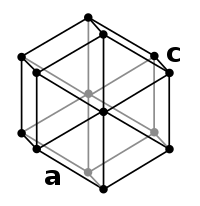
Photo from wikipedia
Hydrocarbon pyrolysis is the main way to achieve carbonaceous materials, while most related conversion mechanisms still remain unclear. This work images pyrolysis of methane at various temperatures and densities by… Click to show full abstract
Hydrocarbon pyrolysis is the main way to achieve carbonaceous materials, while most related conversion mechanisms still remain unclear. This work images pyrolysis of methane at various temperatures and densities by molecular reactive force field (ReaxFF) simulations. First, it is interesting to find that the methane decay is dominated by intermolecular collision displacement instead of direct molecular decomposition. Second, a conversion of 1200 methane molecules into a regular carbon nanocavity (CNC) is realized at 3500 K temperature and 0.1 g/cm3 density after a simulation lasting for 10 ns, with 923 carbon atoms and a diameter of 3.4 nm. Such CNC is a perfect precursor of carbon nanotubes, which is confirmed by a sequent simulation on a larger system of 2400 methane molecules and in agreement with several experimental observations. It is found that the CNC growth obeys a polyyne model, without any single aromatic ring formed in the growth. Furthermore, the complex CNC growth appears in some successive ...
Journal Title: Journal of Physical Chemistry C
Year Published: 2017
Link to full text (if available)
Share on Social Media: Sign Up to like & get
recommendations!